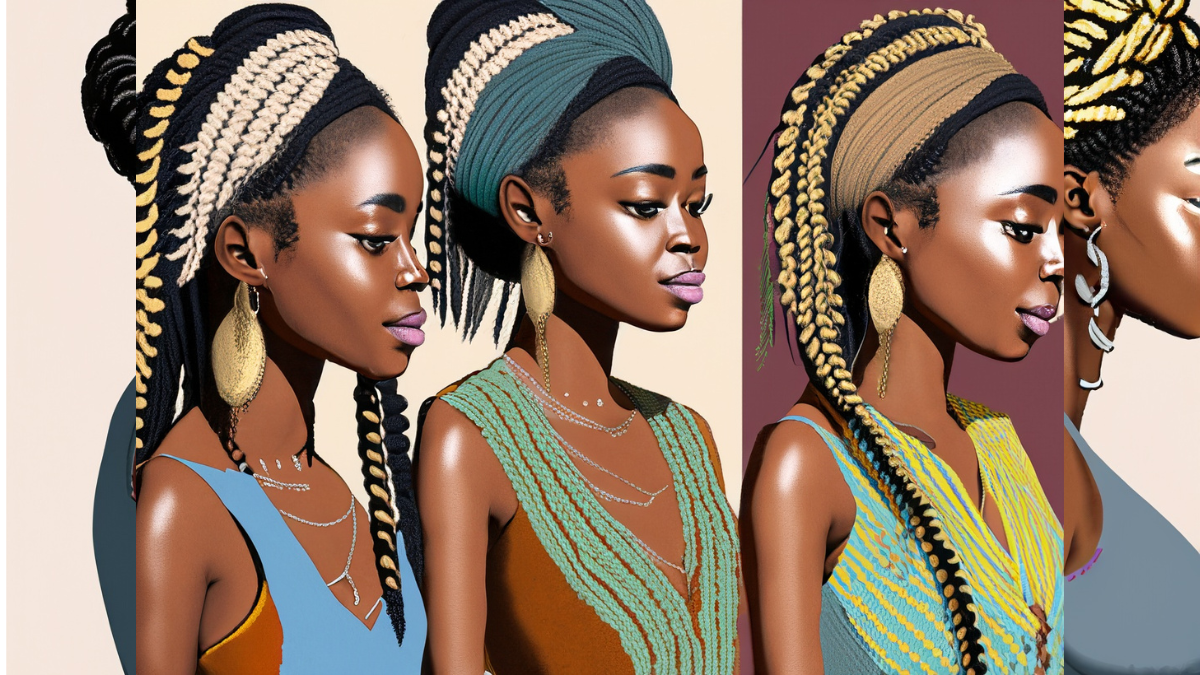For the longest time, there was no love lost between black women and their natural afro hair. Many considered their 4c hair unmanageable and embraced the colonial influence of relaxers, perms and hot combs.
However, in recent years, there’s been a massive shift. Many women are now going au naturel and are completely in love with their tight coils. Additionally, those who still prefer to relax their hair do it as healthily as possible. They incorporate protective and natural hairstyles like mini braids or mini twists and extension hairdos like knotless braids or kinky twists. While those styles are perfectly fine, they can be pretty pricey. Have you seen the cost of hair attachments now? It’s alarming!
So, if you’re tired of repeating the same old natural twists or hair extension prices are threatening to break the bank, you’d be glad to know that there is a truckload of protective Nigerian hairstyles at your disposal. They’re cost-friendly, too. Interested? Then, read on and find out. Before we get into the juicy details, let’s sort out some preliminary questions first.
Table of Contents
What Exactly is a Protective Hairdo?
This question really needs answering because not many people are familiar with the term. Now, if you’re new to the natural hair train or you’re just looking to grow your hair, you must have heard protective hairdo before. Natural hair influencers like Chizi Duru or Klassy Kinks swear by protective styles as a means of growing your hair.
Protective hairdos are styles that keep your hair tucked away from manipulation. These styles protect your hair from both you and the weather. According to hair gurus, too much manipulation (touching) ruins your hair’s natural growth. Therefore, protective styles do the work of keeping your hair safely tucked away. Makes sense, doesn’t it?
While there are many protective styles out there that can do the job, in this article, we’ll be highlighting simple Nigerian hairstyles that can protect your hair even better. The best part is these styles are also economically friendly! So, if you’ve been looking for your next hairdo and you’re a little low on cash, today’s definitely your lucky day!
5 Protective Nigerian Hairstyles: Their Origins and Benefits
Did you know that our Nigerian mothers have been protecting their hair for ages, way before the time of hair extensions and weaves? Our styles today are quite complex. Then, they made simple hairstyles that were efficient in protecting their natural hair. So, without further ado, here are a few protective Nigerian hairstyles you could try.
-
All-back
It is called “Kolese” by the Yoruba’s, “Isi aka” by the Igbos and “Doka” by the Hausa’s. Though the style is similar amongst the tribes, there is a slight variation. The difference is that the ends of the Igbo and Hausa styles are balled up to form a round shape. The Hausas hold the ball with the back of reed stalks while the Yorubas plait the hair to the ends. The Igbo and Hausa style isn’t so popular now, but the Yoruba style is still rampant.
You may also know this style as cornrows. It is the most popular Nigerian hairstyle amongst children, and if we are being honest, it’s what’s under most of our wigs. You only see this style on natural hair or with extensions as Ghana weaving. However, some very artsy ladies wear the natural form of this style daily, decorating it with cowries and beads.
Read also: Natural homemade hair treatment for African women
Irun Kiko or Isi Owu (Threaded Hair)
This style is still quite popular and will continue to be for years. It is usually done with rubber (thread) or wool. For a very simple hairstyle, it does a lot. Many believe it protects as well as helps your hair grow. It is believed that the strain or pressure the rubbers exert on the hair pulls the hair out, therefore making it grow longer. However, there is no science to back up this myth.
Nevertheless, this style is a very effective way to achieve a heatless blowout on natural hair. So, if you’re looking to have a blowout look without the use of heat (blow driers), this is a good go-to. Isi owu is simple, cheap and beautiful. What more could you ask for? All you have to do is rock it with confidence. You can decorate it with hair accessories, and look absolutely gorgeous.
-
Isi Ntukwu (Bantu Knots)
Of all the hairdos in this article, this is probably the most unique Nigerian hairstyle, and yet the least popular. It can be done either with your natural hair alone or with extensions. The hair looks like knots (of your preferred size) around your head. It’s cute, and it’s a very effective protective style as it keeps the ends of your hair tucked away.
Before you jump to any conclusions, this style is in no way childish or immature. Even Rihanna rocked it at a radio award show in 2020. Unlike the other styles mentioned above, this style can be easily retouched. You don’t need to take the whole thing down when it gets old. You can just remove the knot you feel needs the most work and redo it.
Additionally, this style is very good if you’re looking for a curly look. When you take the hair down, you’ll find that your hair has formed voluminous curls, which you can style any way you like.
Read also: How to create a welcoming home as a proud Nigerian woman
-
Tashin Soja
This Hausa style is generally called “Clap your hands”, and is one of the most popular hairstyles for girls. The hair is usually woven from the front and back of the head for them to meet at the centre, hence the clap. It isn’t a common adult style, but it works for all ages. Like the others, it protects the hair, therefore aiding its growth.
-
Shuku
This Nigerian hairstyle fits every girl or woman of any age. You can find both babies and even old women sporting it. The best part is it’s perfect with just your natural hair, and you can choose to spruce it up with an extension. For this simple style, the hair is typically woven from the back and front of your hair in a round shape or manner. All the hair then meets right at the centre of your head.
Read also: Natural beauty tips for Nigerian women
There are so many other lovely Nigerian styles, and you should consider including these styles in your to-dos. Apart from being beautiful, they are all economically friendly. Though you can opt to do these styles with extensions, it may be best to do them without.
While hair extensions are fine and are used for many protective styles, you have to be extra careful when taking them down. Sometimes, hair extensions threaten the protective nature of these styles. They grab onto your natural hair when you’re taking the hair down, thereby causing damage or hair loss. This is why it is advisable to take breaks from extension hairdos once in a while. However, if you’re sure you can carefully take your hair down without snagging out any life-threatening roots, then go right ahead.
Conclusion
Frankly, Nigerian hairstyles are underrated. They are just as good or even better than other styles. With the proper maintenance, hydration, and conditioning, these styles should give you the protection and hair growth you seek.
Connect with us on Instagram. Let’s keep you updated with premium insights. Join our Whatsapp Community here to be a part of our interesting and exciting discussions on navigating life as a Nigerian.
Edited by Halimat Chisom
About Author

-
Akorah Chioma Diana is a recent graduate from the University of Lagos. A creative and content writer, her love for writing began in her Junior Secondary School when she became interested in reading.
A 2021/2022 KANAC Creative writing winner, excerpts of her work can be found in the KANAC Anthology, Pride Magazine Nigeria, and Tush Media Magazine.
Latest entries
 SpiceFebruary 7, 2024Valentine’s Day in Nigeria: Warped Expectations vs What It Should be
SpiceFebruary 7, 2024Valentine’s Day in Nigeria: Warped Expectations vs What It Should be LifestyleJanuary 26, 2024How to Meditate Effectively – Nigerian Style
LifestyleJanuary 26, 2024How to Meditate Effectively – Nigerian Style OpinionJanuary 12, 2024Should You Do a DNA Paternity Test for Your Kids Without Your Partner’s Knowledge?
OpinionJanuary 12, 2024Should You Do a DNA Paternity Test for Your Kids Without Your Partner’s Knowledge?

